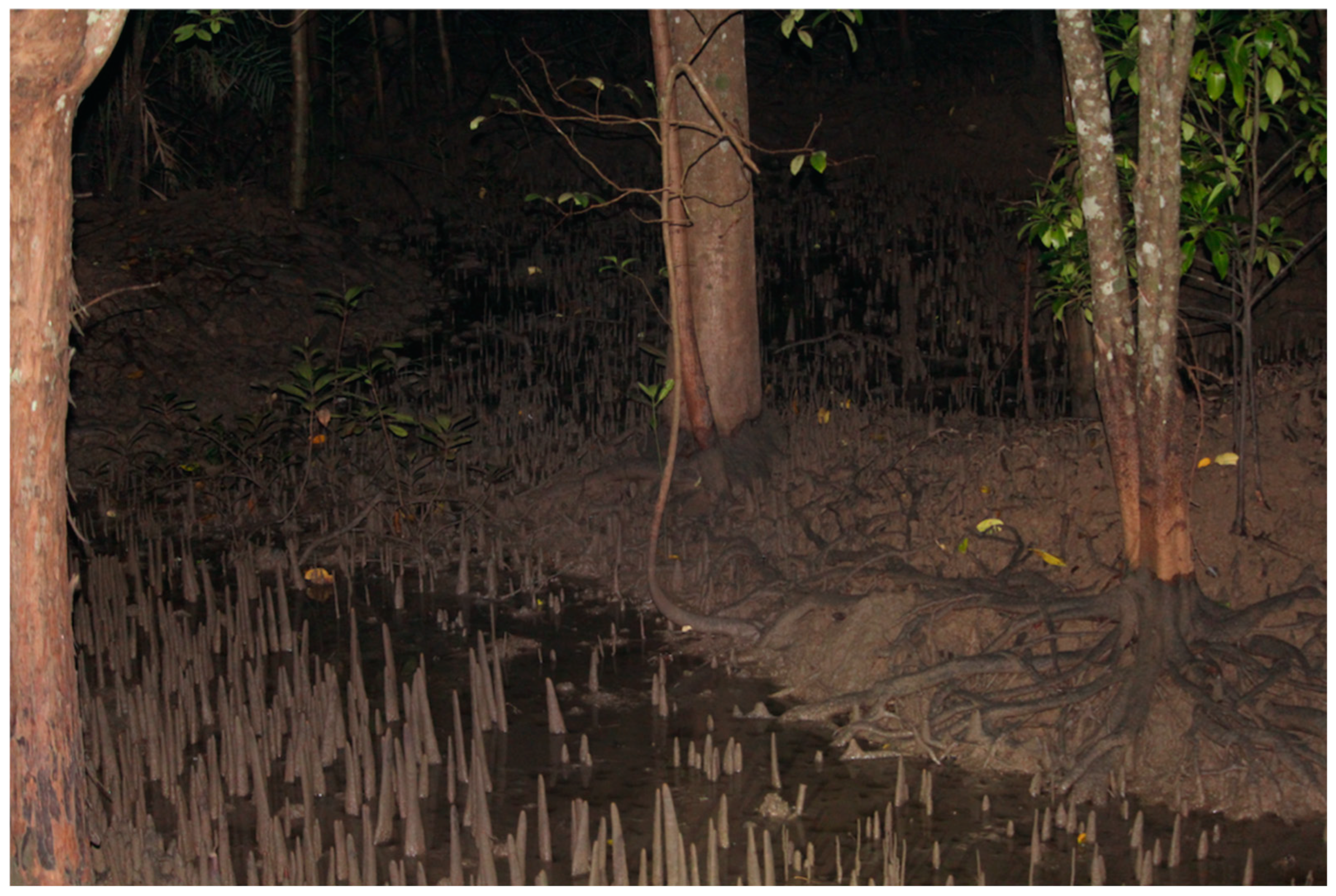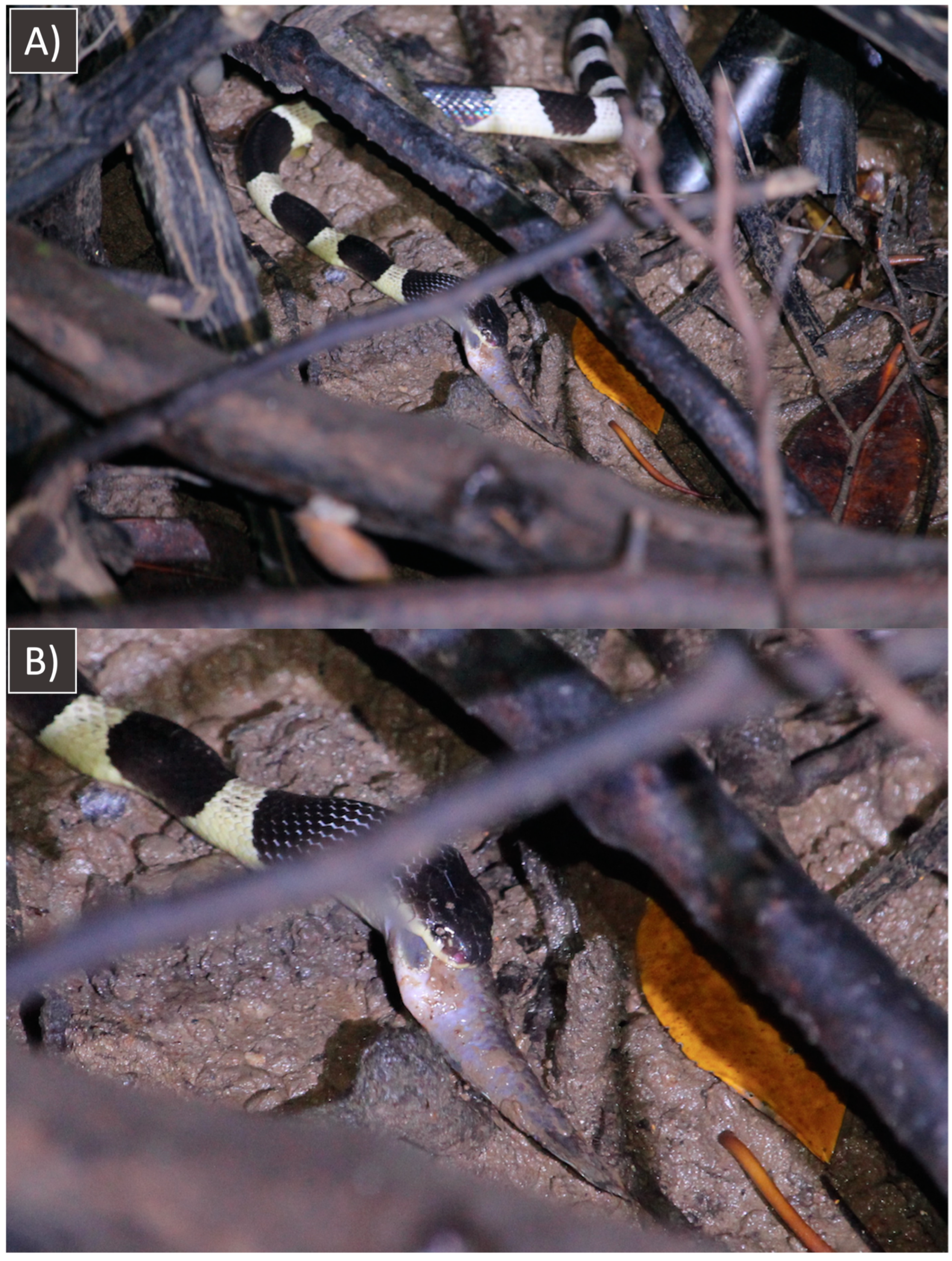A Documented Case of Ichthyophagy in the Malayan Krait (Bungarus candidus) and Its Implications for Toxinology
Abstract
Funding
Institutional Review Board Statement
Data Availability Statement
Conflicts of Interest
References
- Gutiérrez, J.M.; Calvete, J.J.; Habib, A.G.; Harrison, R.A.; Williams, D.J.; Warrell, D.A. Snakebite Envenoming. Nat. Rev. Dis. Primers 2017, 3, 17063. [Google Scholar] [CrossRef] [PubMed]
- Calvete, J.J. Proteomic Tools against the Neglected Pathology of Snake Bite Envenoming. Expert Rev. Proteom. 2011, 8, 739–758. [Google Scholar] [CrossRef] [PubMed]
- Barlow, A.; Pook, C.E.; Harrison, R.A.; Wüster, W. Coevolution of Diet and Prey-Specific Venom Activity Supports the Role of Selection in Snake Venom Evolution. Proc. R. Soc. B Biol. Sci. 2009, 276, 2443–2449. [Google Scholar] [CrossRef] [PubMed]
- Healy, K.; Carbone, C.; Jackson, A.L. Snake Venom Potency and Yield Are Associated with Prey-Evolution, Predator Metabolism and Habitat Structure. Ecol. Lett. 2019, 22, 527–537. [Google Scholar] [CrossRef] [PubMed]
- Modahl, C.M.; Mrinalini; Frietze, S.; Mackessy, S.P. Adaptive Evolution of Distinct Prey-Specific Toxin Genes in Rear-Fanged Snake Venom. Proc. Biol. Sci. 2018, 285, 20181003. [Google Scholar] [CrossRef]
- Lüddecke, T. Quid Pro Quo: A Documented Case of Cannibalism in the Red-Bellied Black Snake Pseudechis porphyriacus in Lamington (Queensland, Australia). Diversity 2023, 15, 610. [Google Scholar] [CrossRef]
- Uetz, P.; Freed, P.; Aguilar, R.; Reyes, F.; Hošek, J. The Reptile Database 2025. Available online: http://www.reptile-database.org (accessed on 31 December 2024).
- Blessmann, J.; Kreuels, B. Urgent Administration of Antivenom Following Proven Krait Bites in Southeast Asia Irrespective of Neurotoxic Symptoms. PLoS Negl. Trop. Dis. 2024, 18, e0012079. [Google Scholar] [CrossRef] [PubMed]
- Pandey, D.P.; Sharma, S.K.; Alirol, E.; Chappuis, F.; Kuch, U. Fatal Neurotoxic Envenomation Following the Bite of a Greater Black Krait (Bungarus niger) in Nepal: A Case Report. J. Venom. Anim. Toxins Incl. Trop. Dis. 2016, 22, 19. [Google Scholar] [CrossRef] [PubMed]
- Pe, T.; Myint, T.; Htut, A.; Htut, T.; Myint, A.A.; Aung, N.N. Envenoming by Chinese Krait (Bungarus Multicinctus) and Banded Krait (B. Fasciatus) in Myanmar. Trans. R. Soc. Trop. Med. Hyg. 1997, 91, 686–688. [Google Scholar] [CrossRef] [PubMed]
- Grossmann, T.; Schäfer, C. Eine Blindwühle der Gattung Ichthyophis Fitzinger, 1826 als Beute des Malayen-Kraits Bungarus candidus (Linnaeus, 1758). Sauria 2000, 22, 45–46. [Google Scholar]
- Lim, B.L. The natural food of some Malayan snakes. Malay. Nat. J. 1956, 10, 139–144. [Google Scholar]
- Slowinski, J.B. The diet of kraits (Elapidae: Bungarus). Herpetol. Rev. 1994, 25, 51–53. [Google Scholar]
- Kuch, U. Notes on the diet of the Malayan Krait, Bungarus candidus (Linnaeus, 1758). Herpetol. Bull. 2001, 75, 10–14. [Google Scholar]
- Mao, J.J.; Norval, G.; Hsu, C.L.; Chen, W.H.; Ger, R. Observations and Comments on the Diet of the Many-banded Krait (Bungarus multicinctus multicinctus) in Taiwan. IRCF Reptiles Amphib. 2010, 17, 73–76. [Google Scholar] [CrossRef]


Disclaimer/Publisher’s Note: The statements, opinions and data contained in all publications are solely those of the individual author(s) and contributor(s) and not of MDPI and/or the editor(s). MDPI and/or the editor(s) disclaim responsibility for any injury to people or property resulting from any ideas, methods, instructions or products referred to in the content. |
© 2025 by the author. Licensee MDPI, Basel, Switzerland. This article is an open access article distributed under the terms and conditions of the Creative Commons Attribution (CC BY) license (https://creativecommons.org/licenses/by/4.0/).
Share and Cite
Lüddecke, T. A Documented Case of Ichthyophagy in the Malayan Krait (Bungarus candidus) and Its Implications for Toxinology. Diversity 2025, 17, 326. https://doi.org/10.3390/d17050326
Lüddecke T. A Documented Case of Ichthyophagy in the Malayan Krait (Bungarus candidus) and Its Implications for Toxinology. Diversity. 2025; 17(5):326. https://doi.org/10.3390/d17050326
Chicago/Turabian StyleLüddecke, Tim. 2025. "A Documented Case of Ichthyophagy in the Malayan Krait (Bungarus candidus) and Its Implications for Toxinology" Diversity 17, no. 5: 326. https://doi.org/10.3390/d17050326
APA StyleLüddecke, T. (2025). A Documented Case of Ichthyophagy in the Malayan Krait (Bungarus candidus) and Its Implications for Toxinology. Diversity, 17(5), 326. https://doi.org/10.3390/d17050326





